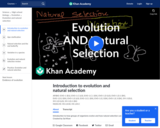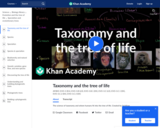
- Subject:
- Biology
- Material Type:
- Unit of Study
- Provider:
- Rice University
- Provider Set:
- OpenStax College


By the end of this section, you will be able to do the following:
Define species and describe how scientists identify species as different
Describe genetic variables that lead to speciation
Identify prezygotic and postzygotic reproductive barriers
Explain allopatric and sympatric speciation
Describe adaptive radiation

By the end of this section, you will be able to do the following:
Describe pathways of species evolution in hybrid zones
Explain the two major theories on rates of speciation

By the end of this section, you will be able to do the following:
Describe how scientists developed the present-day theory of evolution
Define adaptation
Explain convergent and divergent evolution
Describe homologous and vestigial structures
Discuss misconceptions about the theory of evolution

By the end of this section, you will be able to do the following:
Compare homologous and analogous traits
Discuss the purpose of cladistics
Describe maximum parsimony

By the end of this section, you will be able to do the following:
Discuss the need for a comprehensive classification system
List the different levels of the taxonomic classification system
Describe how systematics and taxonomy relate to phylogeny
Discuss a phylogenetic tree's components and purpose

By the end of this section, you will be able to do the following:
Describe horizontal gene transfer
Illustrate how prokaryotes and eukaryotes transfer genes horizontally
Identify the web and ring models of phylogenetic relationships and describe how they differ from the original phylogenetic tree concept


Biology is designed for multi-semester biology courses for science majors. It is grounded on an evolutionary basis and includes exciting features that highlight careers in the biological sciences and everyday applications of the concepts at hand. To meet the needs of today’s instructors and students, some content has been strategically condensed while maintaining the overall scope and coverage of traditional texts for this course. Instructors can customize the book, adapting it to the approach that works best in their classroom. Biology also includes an innovative art program that incorporates critical thinking and clicker questions to help students understand—and apply—key concepts.


By the end of this section, you will be able to do the following:
Identify and describe the properties of life
Describe the levels of organization among living things
Recognize and interpret a phylogenetic tree
List examples of different subdisciplines in biology

This 18-minute video lesson looks at the the vocabulary of DNA: chromosomes, chromatids, chromatin, transcription, translation, and replication. [Biology playlist: Lesson 8 of 71].
Khan Academy learning modules include a Community space where users can ask questions and seek help from community members. Educators should consult with their Technology administrators to determine the use of Khan Academy learning modules in their classroom. Please review materials from external sites before sharing with students.

This 18-minute video lesson provides an introduction to evolution, variation in a population, and Natural Selection. [Biology playlist: Lesson 1 of 71].
Khan Academy learning modules include a Community space where users can ask questions and seek help from community members. Educators should consult with their Technology administrators to determine the use of Khan Academy learning modules in their classroom. Please review materials from external sites before sharing with students.

College-level introductory biology course focusing on the application of the fundamental principles of human biology. Course topics include genetics, cell biology, molecular biology, disease (infectious agents, inherited diseases and cancer), developmental biology, neurobiology, and evolution. Course features include video lectures, audio lectures, subtitles/transcripts, lecture notes, assignments and solutions, and exams and solutions.

This 13-minute video discusses how the Owl Butterfly may have gotten the spot on its wings. [Biology playlist: Lesson 5 of 71].
Khan Academy learning modules include a Community space where users can ask questions and seek help from community members. Educators should consult with their Technology administrators to determine the use of Khan Academy learning modules in their classroom. Please review materials from external sites before sharing with students.

This explanation of genetic drift is straightforward and easy to understand. Illustrations are provided to help visual learners

This 13-minute video lesson looks at the science of taxonomy and where humans fit into the tree of life. [Biology playlist: Lesson 62 of 71].
Khan Academy learning modules include a Community space where users can ask questions and seek help from community members. Educators should consult with their Technology administrators to determine the use of Khan Academy learning modules in their classroom. Please review materials from external sites before sharing with students.